|
Theatregoing
in Chicago has a very
different feel than it
does in New York or
London. Theatres are
not clustered in one
district like Broadway or
the West End, but rather
spread around the city in
various far-flung
neighborhoods – many
in suburbs of greater
Chicagoland. Of course,
there are a number of
prestigious venues in the
Loop, but just like
everything else in the
Midwest, for the most part
you have to drive to your
destination, braving
traffic jams that make New
York and London look like
child's play. Nonetheless,
once you do get there, the
effort is worth it because
the theatres often offer a
complete evening of
entertainment that
includes dinner or
cocktails and nibbles, a
show and in some cases,
like the Marriott, full
resort amenities including
a hotel and golf
course. Having the
theatre companies spread
out across Chicagoland
gives the experience a
neighborhood feeling and
seems to encourage a
broad, local and regular
subscriber base that
becomes the lifeblood of
any theatre company.
Theatregoing in Chicago is
less a tourist activity
and more an integral part
of the fabric of the city.
Our group trip, once again
led by Maine State Music
Theatre, offered the
opportunity to see four
shows in four different
communities, followed by
excellent talkbacks with
cast and creatives led by
Curt Dale Clark and Marc
Robin, whose own
award-winning careers in
Chicago are the stuff of
legend.
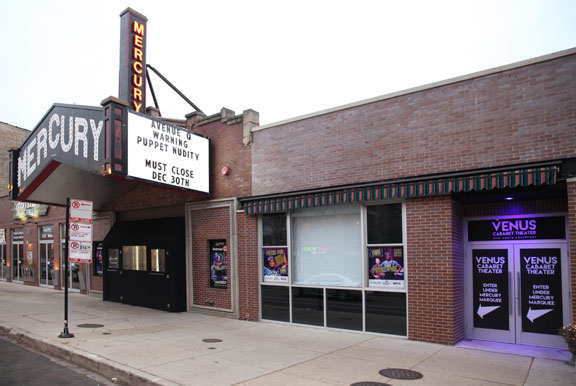
The first evening was a return to the tiny 530-seat Mercury Theater
tucked away in Chicago's Southport neighborhood – a trendy
residential area about twenty-five minutes from downtown, filled with
charming brownstones, boutiques and bistros. The company, which
operates with a combination of Equity and Non-Equity contracts and
often does edgy works, has a loyal local following who give the
audience a palpable feeling of energy and passionate enthusiasm. On
the night that we saw Rock of Ages, it was evident that many of the
audience members were returning patrons.
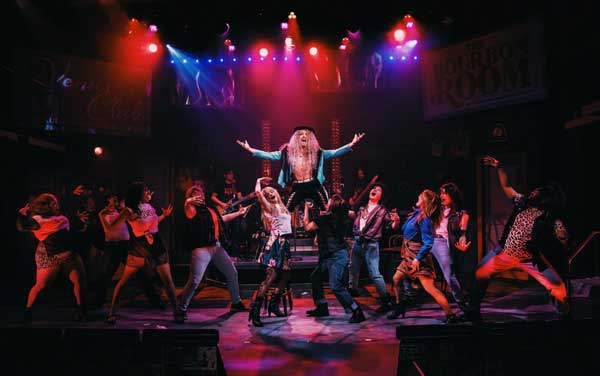
Directed by Tommy Novak, the production stressed the darker side of
the rock experience of the 1980s – the struggles to make a living for
artists, the tensions between club owners and local businesses, the
generally provocative and drug-laced culture of many of the rock
bands of the era. While this is a love story, as well as an encyclopedic
revue of some of the greatest songs of the period, it is not a sugary or
pretty one. Told with humor and realism, the characters come to life in
moments of vivid intensity. The young couple Sherrie (Kayla Marie
Shipman) and Drew (David Moreland), whose romance is fraught with
hard knocks, both gave a fresh credibility vocally and dramatically to
their roles, and Moreland, particularly, managed the high rock
tessitura of the part. Michael Metcalf had great fun engaging the
audience in an impudent, yet winning way as Lonny, the de facto
narrator of the piece, while Steve Watts was a weathered but touching
club owner, Dennis. Donovan Hoffer as Stacee Jaxx pulled out all the
stops to create a libidinous, narcissistic, drug-addled rocker. As the
"villains" of the piece, the German real estate developers, Hertz and
Franz, Jeff Diamond and Aaron Davidson gave colorful
characterizations. Veronica Garza as the sympathetic town official,
Regina, proved a master of physical and verbal comedy. The four-piece
on stage band, led by Kailey Rockwell, played with virtually non-stop
gusto.
The unit set by Bob Knuth with the bandstand as its central focus, and
several levels to add variety and different locales was appropriately
seedy-looking, yet offered a few fun surprises such as the reveal of the
bathroom interior for a crucial scene. While the overall level of talent
in the large cast was uneven, the commitment, energy, and musical
engagement of the principals was sufficient to carry the evening.
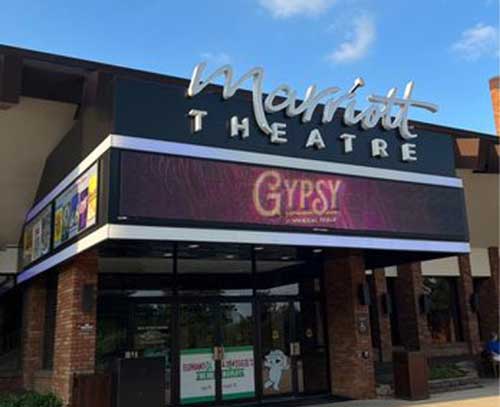
The second offering was for me, a much-anticipated return to the
Marriott Lincolnshire, one of America's few theatre-in-the-round
venues, situated in a lovely affluent suburb north of Chicago. The
campus includes a hotel, restaurant, golf course and well- manicured
acreage. In the 1980s when we lived in Chicago, I had been a
subscriber, and in the year's following this theatre had been a home to
some of Chicago's greatest talents. Acclaimed for their productions of
the standard repertoire, this production of Gypsy, directed by Amanda
Dehnert and choreographed by Stephanie Clemons proved a
disappointment. There was an overall blandness to the concept, a kind
of formulaic deployment of the in-the-round blocking and lackluster
choreography. The minimalist décor by Collette Pollard seemed a
shadow of years-gone by when the entire auditorium would be decked
out to integrate it with the stage. And Theresa Ham's costumes lacked
the contrast between simple on-the-road attire and the final glamour of
stardom.
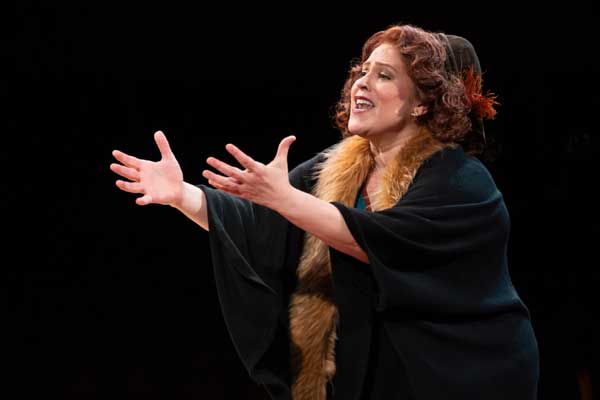
Regrettably, too, the cast seems as uninspired as their surroundings.
Lucia Spina as Mama Rose is blessed with a powerful voice, but one
never felt her connection to the crazed intensity of the character.
Nathaniel Stampley as Herbie also sang beautifully but gave a one-note
dramatic performance – never creating the contrast between a man
besotted and one betrayed. Laura Medina Medina was credible as plain
Louise but less so as the transformed and elegant Gypsy Rose Lee. Tore
Heinlein (Baby June) and J. Kobe Wallace (Tulsa) did not convince of
their talent, and Tulsa's solo dance number was flat. If anything
rescued the evening, it was the still glorious Jule Styne score with
Stephen Sondheim lyrics and Arthur Laurents book – one the most
cohesive musicals in the canon – and the pleasure, however flawed, of
seeing the work performed in the round – an experience that is
becoming a theatrical rarity.
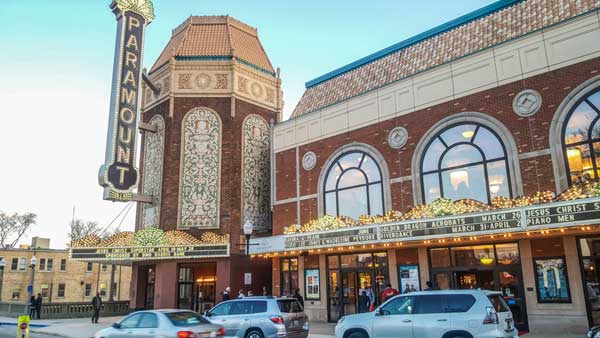
The third evening took us on a journey westward to Aurora, the second
largest city in Illinois, where the recently restored Paramount Theatre
is one of those miracles of visionary development. Built in 1931, this
885 -seat house has been a grand palace for the performing arts. Its
magnificent Art Deco interior by C.W. and George L. Rapp and
imposing façade earned it National Historic Register status. In 1976
the building underwent major restoration; in 2006 a new lobby was
added increasing the amenities of the space, and in 2011 Broadway
veteran and Chicago native Jim Corti became Artistic Director,
inaugurating the Broadway series of in-house produced shows and
once again putting the venue on the map. Today, the Paramount
Theatre is not only a destination, but it is the economic engine that has
revived businesses and the beauty of downtown Aurora.
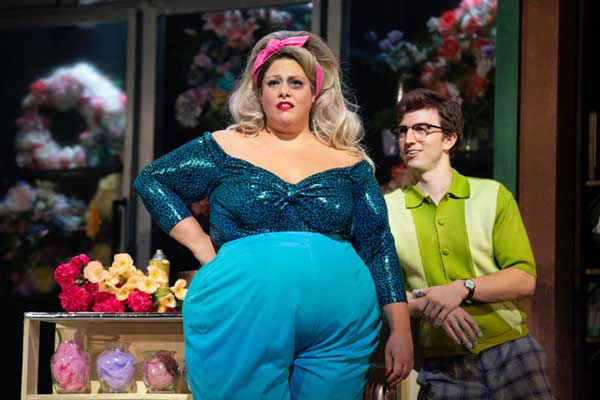
A pre-performance tour of the building by Corti was a great treat,
followed by dinner at a local restaurant, and then a preview of Little
Shop of Horrors. While the show was still working out its kinks, my
chief quibble with the production was the overall visual/directorial
concept, itself. Little Shop of Horrors is meant to be a small-scale, low-
key production – nothing grand or bombastic. Yet, the very size of the
theatre seemed to compel director, Landree Fleming and set
designer, Jeffrey D. Kimiec, together with all the creatives, to opt for a
larger-than-life feeling. The production, though Kimiec's recreation of
Skid Row with lighting by José Santiago was stunning to look at,
dwarfed the music, the characters, and the fragile theme of the work.
With an outsized puppet, Audrey II, the entire ambiance was that of a
Stephen King movie rather than a small, sleezy, eccentric set of people,
events, and slender musical score by Alan Menken.
Similarly, the cast seemed overpowered by the concept and setting.
Jack Ball was a colorless Seymour, as was Teressa La Gamba as
Audrey. As the abusive, sadistic dentist, Russell Mernagh was not
creepy enough, and only Gene Weygandt as Mr. Mushnik came close to
winning audience sympathy for his character.
Perhaps the fault with this production is trying to mount it in the grand
Paramount Theatre rather than in their small, experimental theatre
space, but one could not help thinking that the skilled work of the
design and creative team could have been rescued by more incisive
direction and by a cast who projected character and vocal strength on a
scale commensurate with the surroundings.
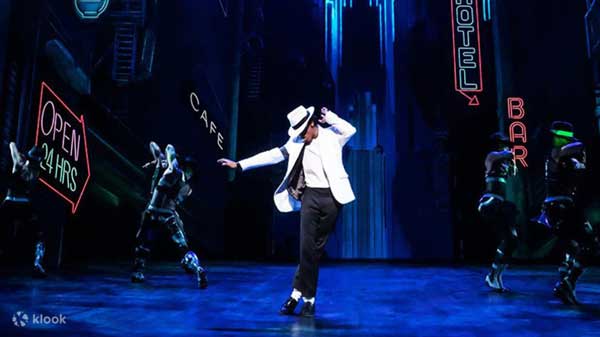
The final night was an excursion into the Loop to the James
Nederlander Theatre (formerly the Oriental Theatre), another grand,
insanely ornate 1920s architectural creation by the Rapps, capable of
seating 2253 patrons, to see the Chicago production of the Broadway
hit MJ. With a rousing score by Michael Jackson and his
contemporaries and a tightly-constructed book by Lynn Nottage, this is
a compelling biopic told through song and dance.
Directed and choreographed by Christopher Wheeldon, the show tells
Jackson's gripping journey from child star, exploited and abused by his
father, to the international pop icon he would become. Nottage's book
uses the framework of a rehearsal for Jackson's Dangerous Tour to
present the artist as an adult with flashbacks to his past. Jackson's
artistic vision and aspirations, his demons from the past and present
are vividly portrayed by a superlative Roman Banks, who brilliantly
captures the star's body language, his soft-spoken speaking voice, and
his powerful singing instrument. His charisma is matched by Devon
Bowles' incisive dual performance as Michael's demanding father
Joseph Jackson and his current tour manager, Rob. In the role of the
filmmaker Rachel, Mary Kaye Moore treads a fine line between being
an aggressive and sympathetic journalist. Brandon Lee Harris
energetically plays a younger version of Michael Jackson with Ethan
Joseph as the child Jackson – both excellent dancers. Anastasia Talley
is a dignified and soft-spoken Katherine Jackson, though her big vocal
moment is a bit underwhelming. The entire ensemble is comprised of
dazzling dancers and singers. who execute Jackson's repertoire with
passion and flair.
The musical aspects of the show under the direction of David
Holcenberg are compelling, as are the visual elements. Using neon
lights, geometric patterns, projections, and minimal props, Derek
McLane's set with lighting by Natasha Katz shimmers and surprises –
especially in the final number for Michael Jackson. Paul Tazewell's
costumes recreate the razzle dazzle of a Michael Jackson performance.
MJ packs a big punch as a production. Jackson's songs, encased in the
glittering fireworks of his performance aesthetic, make this show
exciting, at the same time that the strong storytelling gives the
audience a compassionate and fascinating account of this musical
phenomenon.
The variety of the week's theatre adventures made the entire
experience a joy. Even though the overall production quality was
uneven, the enthusiasm of the Chicago public for theatre-going and the
way in which communities embraced their "local" theatre were hugely
heartening. In a city as vast and diverse as Chicago, theatre is one way
for communities to create an identify and to define themselves with
pride.
|